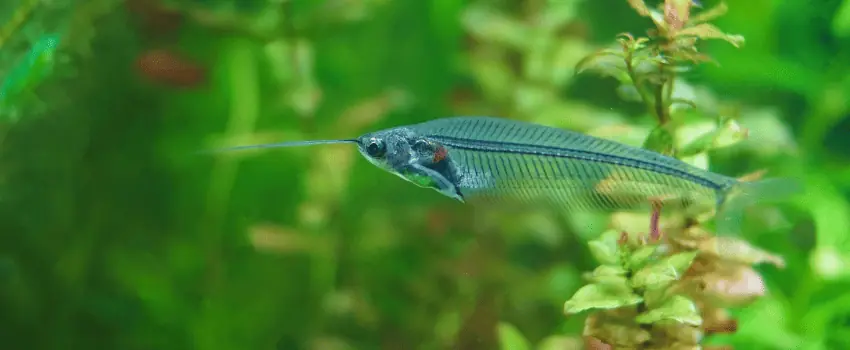Bettas are curious fish with great personalities and need some company, or they get bored. Many fish keepers buy a tank buddy for their betta to keep them company.
Glass catfish, also known as ghost catfish, are peaceful, shoaling fish who thrive in the same conditions as your betta. They are also from Southeast Asia.
But are they good community tank mates for a betta?
Glass catfish and bettas make good tank mates, provided you give the glass catfish the conditions they need. They need, at a bare minimum, 3 others of their kind to live with. They require a 30-gallon tank with lots of horizontal swimming space, slow-moving water, and plenty of hiding places.

Table of Contents
Glass Catfish And Betta Comparison

Betta Fish
Bettas are gorgeous fish with long, flowing, colorful fins. They have a lot of personalities and need an enriching, exciting environment with lots of places to rest and hide.
The natural habitat bettas come from is Asia, Africa, and Australasia. They live in still or slow-moving water with more vegetation.
Bettas need at least a 5-gallon tank with plenty of plants to rest on or hide in. Providing breaks to their line of sight helps reduce stress and aggression towards other fish.
Bettas are territorial fish and are known for their aggression. They will pick on colorful, showy fish, so do not choose this type of fish for your betta tank.
Female bettas are less aggressive than males, but it is still wise to consider their tank mates carefully.
The ideal water conditions for betta fish are a water temperature of 78-80° degrees Fahrenheit (25.5-27° C), a more neutral pH of 6.5-7.5, and slightly softer water.
Ensure you do not have sharp rocks in your substrate to injure your pet.
Glass Catfish

Glass catfish are graceful, translucent fish. Unusual for catfish, they prefer swimming and eating in the middle of the tank rather than the bottom.
They have barbels, a sensory organ, on their head like other catfish. They are different in they like to swim in shoals.
You’ll need at least 3 glass catfish just to survive, 5-6 to be happy, and 10-12 to thrive.
Glass catfish are peaceful fish and have a high energy level. Because, as a group, they put a greater bio-load on your tank; they require a much larger tank than just a lone betta.
They also grow to about 2.5″ inches with a slender body, so if you have 6 of them, so, using the rule of thumb of 1″ inch of fish per gallon, you will need at least 15 gallons of water just for their use.
These fish require a 30-gallon tank with lots of plants such as java moss, java ferns, hornwort, and tunnels and caves to hide in. They also need a wide open space for swimming.
If the glass catfish experience aggression from your betta, make sure you have space to separate them.
Designing your aquarium to give the betta small territories away from the glass catfish’s swimming area helps keep the betta from getting aggressive.
Aquatic plants help immensely with this.
Similarly to bettas, these fish prefer softer, slightly acidic water from about 75-80° degrees F (24-27° C) and need softer substrates like sand or small pebbles to keep their barbels safe.
They need a slow water flow, or the water currents will make them struggle to swim.
Can Glass Catfish And Betta Get Along?

Since they have similar water parameters and compatible temperaments, betta fish and glass catfish can get along well in the same tank, provided there is enough room.
It is also essential to feed them properly.
Both glass catfish and bettas eat a meaty diet. Live or frozen food of daphnia, bloodworms, mosquito larvae, and brine shrimp are all tasty for them.
Glass catfish also need some plant-based food in their diet. The difficulty will be in making sure every fish gets what they need.
Bettas are usually food-aggressive and eat the food at the top of the tank. This makes it harder for the glass catfish to get any in their preferred feeding area, the middle.
One solution to this problem is feeding the fish on opposite sides of the tank, perhaps with sinking pellets. This food will reach the glass catfish sooner.
This may or may not work, as getting the fish to go to separate ends will be difficult.
Another technique is to catch your betta in a net and keep him separated until the catfish have eaten. This is stressful for the betta, however.
The main thing is watching your fish to ensure they are all getting enough to eat; they might be fine without your intervention.
Remember not to overfeed; it is unhealthy for the fish and makes the water dirty.
What Fun Fish Are Compatible with Betta fish?

Peaceful fish without flowy colorful fins are better tank mates for betta fish.
Here is a list of other betta-compatible fish:
- Ember Tetras
- Rummy Nose Tetras
- Cardinal Tetras
- Neon Tetras
- Black Neon Tetras
- Guppies (Females only)
- Platys
- Harlequin Rasboras
- Lambchop Rasboras
- Dwarf Rasboras
- Scissortail Rasboras
- Chili/Mosquito Rasbora
- Bronze (Common) Corys
- Endlers Livebearers
- Dwarf Loach
- Mollies
- Ghost shrimp
- Otocinclus Catfish
Male bettas do not live peacefully with other bettas. They will fight and injure each other, often to the death.
Female betta fishes can live with other female bettas. This grouping of 4 to 6 fish is called a sorority or sometimes a harem.
What Fish Get Along with Glass Catfish?

Make sure that in your community tank, there are no large predators or aggressive fish (including your betta). This fish enjoys living with other peaceful species of around the same size.
Here is a list of compatible glass catfish tank mates:
- Celestial Pearl Danios
- Mollies
- Swordtails
- Neon Tetra
- Kuhli Loach
- Rummy Nose Tetra
- Dwarf Gourami
- Panda Cory
- Cory Catfish
Health and Disease Prevention for Your Fish

Both bettas and glass catfish are sensitive to water quality and need stable water conditions to remain healthy. Both fish are also sensitive to stress and need careful management.
With fish, as with humans, an ounce of prevention is worth a pound of cure. Follow a routine water change and tank maintenance schedule to help keep water quality stable.
Ensure your fish have a varied, nutritious diet and plenty of room for exercise and hiding. Monitor your pets for illness or injury and isolate them if they are sick.
If your glass catfish becomes ill, its transparent body can turn a milky white. There are no species-specific diseases to worry about, just the normal ones that affect all freshwater aquarium fish.
Glass catfish care is a little more tricky than regular aquarium care for other, more hardy fish. The temperature needs to remain constant, and the water quality needs to be very good.
Should your fish become stressed, it will lower their immune system function. This makes them vulnerable to bacterial, fungal, and parasitical illnesses.
Isolate the sick fish in a hospital aquarium and treat them.

If you need to use aquarium salts for your betta’s treatment, make doubly sure you remove them to a quarantine tank. Aquarium salts are toxic to glass catfish and should not be used with them.
Betta fish suffer most commonly from fin rot. Over 79% of the time, this is from injury from décor.
When doubting whether an item of décor is suitable, run a piece of tissue paper along the edge.
If the tissue tears, it is sharp enough to tear your poor betta’s fins, leading to bacterial infection and fin rot. Even items labeled “betta safe” are often not.
The second most common affliction of bettas is being “fat,” which might be from overfeeding, a tumor, or bacteria. The only way to tell is to take your betta to a veterinarian!
Betta fish also succumb to most freshwater parasites, such as ich and velvet disease. Maintaining healthy water conditions and quarantining new fish is the best prevention.
Glass catfish and betta fish can suffer from most freshwater fish diseases, including:
- Lice – a parasitic infection
- Fungal Infection – white patches on the body
- Ich – white sand-like grainy rashes on the body
- Dropsy – protruding and bloating scales
- Fin Rot – infection on the fins of the fish
Check out our complete list of common betta illnesses and what to do about them.
Some signs your fish may be sick are:
- Loss of appetite and lethargy
- Clamped fins
- Swimming erratically
- Lesions
- Color loss
- Weight loss
- Cloudy eyes
- Bloating
- Labored breathing
- Watery discharges
- Frayed fins
Roommate Wanted
If your betta isn’t too aggressive to have company, glass catfish make great tank mates for betta fish.
They have similar water and food requirements and a peaceful temperament, making them ideal for living with a betta in a large fish aquarium.
Glass catfish are more sensitive fish than bettas and need a stable tank. They are less hardy and require several of their own kind to thrive.
Check out our massive list of good (and bad) betta tank companions for more ideas.


